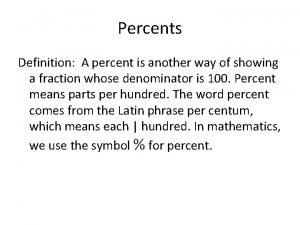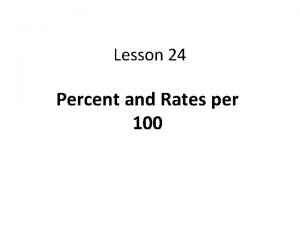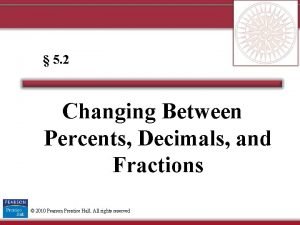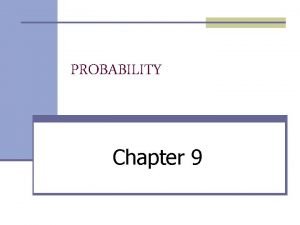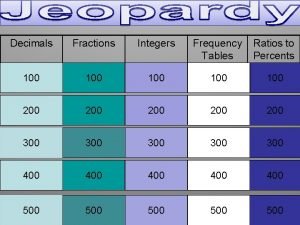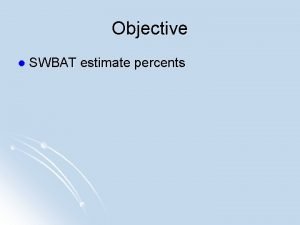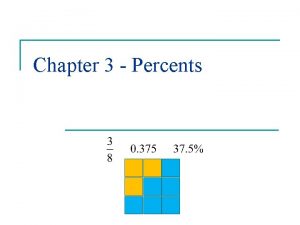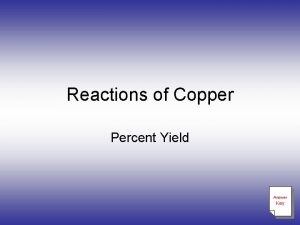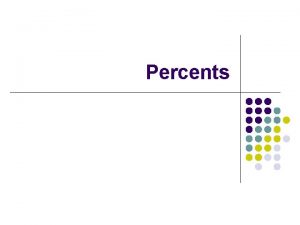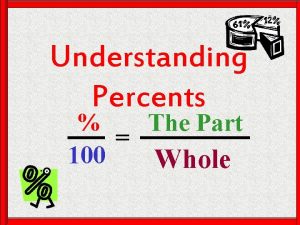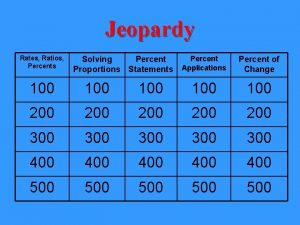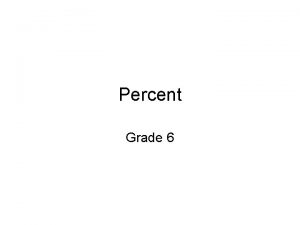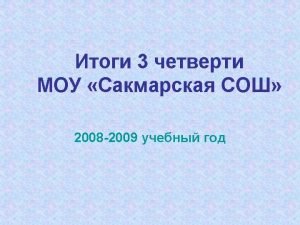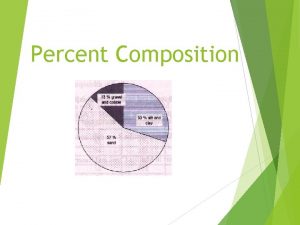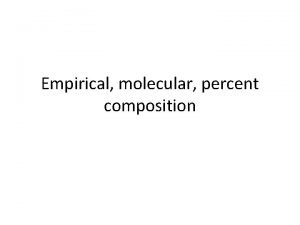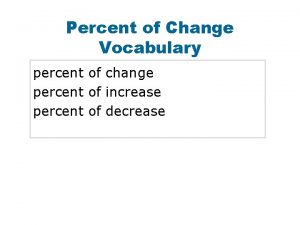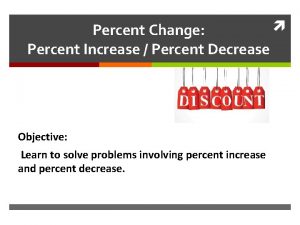Chemical Calculations Percents Percent means parts of 100





























- Slides: 29

Chemical Calculations

Percents • Percent means “parts of 100” or “parts per 100 parts” • The formula: Part x 100 Percent = Whole

Percents • If you get 24 questions correct on a 30 question exam, what is your percent? 24/30 x 100 = 80% • A percent can also be used as a RATIO – A friend tells you she got a grade of 95% on a 40 question exam. How many questions did she answer correctly? 40 x 95/100 = 38 correct

Percent Error • Percent error = |accepted value – experimental value| X 100 percent accepted value • Percent error is used to find out the degree of error you have in an experiment. • There will always be some error, scientists like to keep error below 2 %.

Density • Density- the ratio of the mass of a substance to the volume of the substance. - Expressed as: Liquids & solids= grams/cubic centimeters Gasses= grams/liters - Density = Mass/Volume = g/cm 3 - Mass = Density X Volume - Volume – Mass / Density

Density D=M/V • Calculate the density of a piece of metal with a volume of 18. 9 cm 3 and a mass of 201. 0 g. D= 201. 0 g / 18. 9 cm 3 = 10. 6 g/cm 3 • The density of CCl 4 is 1. 58 g/m. L. What is the mass of 95. 7 m. L of CCl 4? 1. 58 g/m. L = X / 95. 7 m. L X = 1. 58 g/m. L X 95. 7 m. L X = 151 g • What is the volume of 227 g of olive oil if its density is 0. 92 g/m. L? X = 227 g / 0. 92 g/m. L = 227 g / X X= 247 or 2. 5 X 102 m. L

Density and % Error Practice • If you were given an object that had a length of 5. 0 cm, a width or 10. 0 cm and a height of 2. 0 cm, what would the density of this object be if you weighed it and found that it had a mass of 800. 0 g? 5. 0 cm X 10. 0 cm X 2. 0 cm = 100 cm 3 D = 800. 0 g / 100 cm 3 = 8. 0 g/cm 3 • What would the % error be for your measurments if I told you the accepted value for the density of this object is 8. 50 g/cm 3? Is this acceptable? Explain. 8. 0 – 8. 5 / 8. 5 X 100 = 5. 9% No, the % error is greater than 2 %

Concentration Measurements • Molarity: M – Molarity = mol solute / L solution – Use in solution stoichiometry calculations – Mole solute = Molarity X Liters solution – Liters solution = moles solution / Molarity • Molality: m – mol solute / kg solvent – Used with calculation properties such as boiling point elevation and freezing point depression • Parts per Million: ppm – g solute / 1 000 g solution – Used to express small concentrations Pg. 460

Molarity • What is the molarity of a potassium chloride solution that has a volume of 400. 0 m. L and contains 85. 0 g KCl? • Gather Info Volume of solution = 400. 0 m. L Mass of solute = 85. 0 g KCl Molarity of KCl solution = ? • Plan Work – Calculate the mass of KCl into moles using molar mass: 1 mol 85. 0 g KCl = 1. 14 mol KCl 74. 55 g KCl – Convert the volume in milliliters into volume in liters 400. 0 m. L 1 L = 0. 4000 L 1000 m. L • Calculate – Molarity is moles of solute divided by volume of solution 1. 14 mol KCl = 2. 85 mol / L = 2. 85 M KCl 0. 4000 L Pg. 465

Parts Per Million • A chemical analysis shows that there are 2. 2 mg of lead in exactly 500 g of water. Convert this measurement to parts per million. • Gather Info Mass of Solute = 2. 2 mg Mass of Solvent = 500 g Parts per Million = ? • Plan Work – First change 2. 2 mg to grams 1 g 2. 2 mg = 2. 2 X 10 -3 g 1000 mg - Divide this by 500 g to get the amount of lead in 1 g water, then multiple by 1, 000 to get the amount of lead in 1, 000 g water. • Calculate 0. 0022 g Pb 500 g H 2 O 1, 000 parts 1 million = 4. 4 ppm Pb ie: 4. 4 parts Pb per million parts H 2 O Pg. 461

Specific Heat • Specific Heat – the quantity of energy that must be transferred as heat to raise the temperature of 1 g of a substance by 1 K. • The quantity of energy transferred as heat depends on: 1. The nature of the material 2. The mass of the material 3. The size of temperature change • Ex: 1 g of Fe 100°C to 50°C transfers 22. 5 J of energy. 1 g of Ag 100°C to 50°C transfers 11. 8 J of energy. à Fe has a larger specific heat than Ag à Meaning that more energy as heat can be transferred to the iron than to the silver

Explain Specific Heat in My Terms • Metals = Low Specific Heat = little energy must be transferred as heat to increase temperature. • Water = High Specific Heat (Highest of most common substances) = can absorb a large quantity of energy before temperature increases.

Specific Heat Formula Cp = specific heat at a given pressure (J/g • K) q = energy transferred as heat (J) m = mass of the substance (g) Cp = ∆T = difference btwn. initial and final temperatures (K) (Final Temp – Initial Temp) Q = Cp (m X ΔT) Mass = (Cp)(ΔT) / Q q___ m X ∆T

Specific Heat Example (pg. 61) • A 4. 0 g sample of glass was heated from 274 K to 314 K and was found to absorb 32 J of energy as heat. Calculate the specific heat of this glass. 1. Gather Info A. Mass (m) of sample = 4. 0 g B. Initial Temp = 274 K C. Final Temp = 314 K D. Amt. of Energy absorbed (q) = 32 J 2. 3. - Plan Work Cp = q___ m X ∆T Calculate Fill in formula 32 J Cp = _______ = 4. 0 g X 40 K 2 SD 32 J = _____ 160 g • K 2 SD 0. 20 J/g • K

Practice Problems Page 61 1 -4

Specific Heat #1 • Calculate the specific heat of a substance if a 35 g sample absorbs 48 J as the temperature is raised from 293 K to 313 K. Be sure to use the correct number of sig. figs. in your answer.

Specific Heat #2 • The temperature of a piece of copper with a mass of 95. 4 g increases from 298. 0 K to 321. 1 K when the metal absorbs 849 J of energy as heat. What is the specific heat of copper? Use Sig Figs.

Specific Heat #3 • If 980 k. J of energy as heat are transferred to 6. 2 L of H 2 O at 291 K, what will the final temp of H 2 O be? The specific heat of water is 4. 18 J/g • K. Assume that 1. 0 m. L of H 2 O equals 1. 0 g or H 2 O. Use Sig Figs.

Specific Heat #4 • How much energy as heat must be transferred to raise them temperature of a 55 g sample of Al from 22. 4°C to 94. 6°C? The specific heat of Al is 0. 897 J/g • K. Note that a temperature change of 1°C is the same as a temperature change of 1 K because the sizes of the degree divisions on both scales are equal. Use Sig Figs.

Enthalpy • Enthalpy- the sum of the internal energy of a system plus the product of the system’s volume multiplied by the pressure that the system exerts on its surroundings. (heat content, total energy of the system) • When calculating enthalpy if the change in enthalpy is positive, it means that heating the sample requires energy making it an endothermic process. (run up the hill) • When the change is negative, the sample has been cooled, meaning that the sample has released energy making it an exothermic process. (fall down the hill)

Molar Enthalpy Formula ∆H = molar enthalpy (J/mol) C = molar heat capacity (J/K • mol) ∆T = change in temperature (K) ∆H = C∆T C = ΔH / ΔT Note: A mole is the amount of a substance

Molar Enthalpy Heating • How much does the molar enthalpy change when ice warms from -5. 4°C to -0. 2°C? The molar heat capacity of H 2 O(s) is 37. 4 J/K • mol 1. Gather Info Initial Temp = -5. 4°C = 267. 6 K Final Temp = -0. 2°C = 272. 8 K C = 37. 4 J/K • mol 2. Plan Work ∆H = C∆T 3. Calculate ∆H = 37. 4 J/K • mol (272. 8 K – 267. 6 K) = (37. 4 J/K • mol)(5. 2 K) = 194. 48 J/mol = 194 J/mol Pg. 346

Molar Enthalpy Cooling • Calculate the molar enthalpy change with an aluminum can that as a temperature of 19. 2°C is cooled to a temperature of 4. 00°C. The molar heat capacity for Al is 24. 2 J/K • mol. 1. Gather Info Initial Temp = 19. 2°C = 292 K Final Temp = 4. 00°C = 277 K C = 24. 2 J/K • mol 2. Plan Work ∆H = C∆T 3. Calculate ∆H = (24. 2 J/K • mol)(277 K – 292 K) (24. 2 J/K • mol)(-15 K) = -363 J/mol Pg. 347

Enthalpy Practice Page 346 1 & 2 Page 347 1 & 2

Page 346 #1 • Calculate the molar enthalpy change of H 2 O(l) when liquid water is heated from 41. 7°C to 76. 2°C.

Page 346 #2 • Calculate the ∆H of Na. Cl when it is heated from 0. 0°C to 100. 0°C.

Page 347 #1 • The molar heat capacity of Al(s) is 24. 2 J/K • mol. Calculate the molar enthalpy change when Al(s) is cooled from 128. 5°C to 22. 6°C.

Page 347 #2 • Lead has a molar heat capacity of 26. 4 J/K • mol. What molar enthalpy change occurs when lead is cooled from 302°C to 275°C.

Simple Conversions • If you had 6. 0 mops, how many pops would you have? 2 kops = 4 nips 1 dip = 6 jips 1 fop = 3 gops 1 pop = 3 gops 3 mops = 6 jips 7 dips = 2 nips 3 kops = 1 fop 6. 0 mops 6 jips 1 dip 2 nips 2 kops 1 fop 3 gops 1 pop 3 mops 6 jips 7 dips 4 nips 3 kops 1 fop 3 gops = 0. 0952 pops = 9. 5 X 10 -2 pops
 100 100 100 100 100
100 100 100 100 100 Percent greater than 100 and less than 1
Percent greater than 100 and less than 1 Structural steel connection calculations calculations
Structural steel connection calculations calculations Valid percent چیست
Valid percent چیست The calculations of quantities in chemical reactions
The calculations of quantities in chemical reactions At a local
At a local Lesson 24 percent and rates per 100
Lesson 24 percent and rates per 100 Maurice amiel villorente
Maurice amiel villorente Converting between percents decimals and fractions
Converting between percents decimals and fractions Reteaching 9-1 review percents and probability
Reteaching 9-1 review percents and probability Frequency table with decimals
Frequency table with decimals Percents to decimals
Percents to decimals Estimating with percents
Estimating with percents Put these decimals in order starting with the smallest
Put these decimals in order starting with the smallest 6-2 relate fractions decimals and percents
6-2 relate fractions decimals and percents Ordering fractions decimals and percents
Ordering fractions decimals and percents Lesson 3 percents and decimals
Lesson 3 percents and decimals Two sevenths as a decimal
Two sevenths as a decimal Lesson 6-2 fractions, decimals, and percents answers
Lesson 6-2 fractions, decimals, and percents answers Converting between percents decimals and fractions
Converting between percents decimals and fractions Estimating percents
Estimating percents Fractions decimals and percents calculator
Fractions decimals and percents calculator Contoh skala desimal
Contoh skala desimal Cent percent means
Cent percent means Answer key
Answer key 400 ün 12 si kaçtır
400 ün 12 si kaçtır 200+200+100+100
200+200+100+100 Gcse box plot questions
Gcse box plot questions Malloc lab 100/100
Malloc lab 100/100 1453-1337
1453-1337





